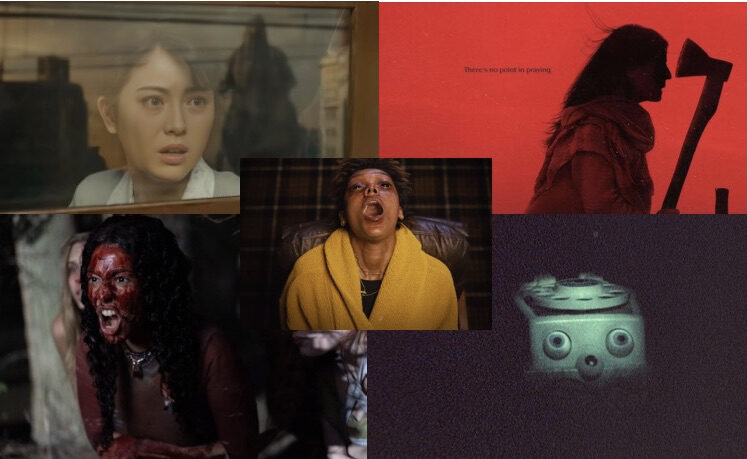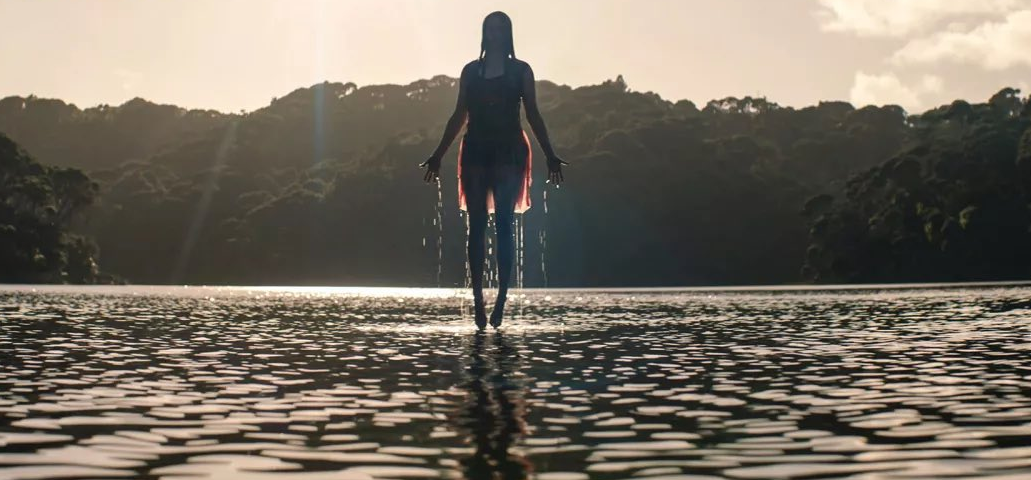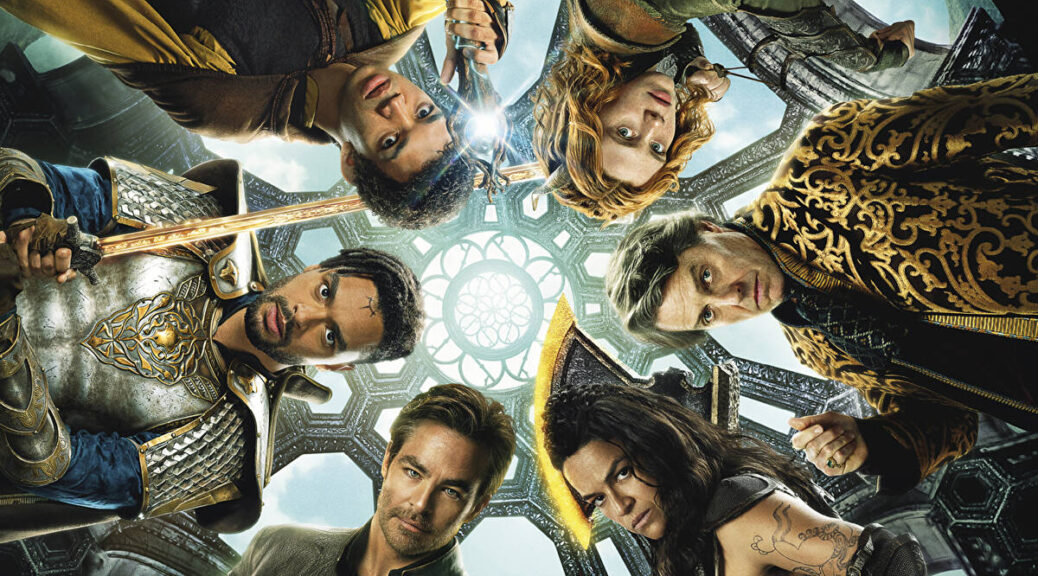Blood soaked comedies, visceral supernatural thrillers, gory satires, haunting social commentaries, throwbacks and holidays and gore galore – that’s what was on display in the best horror films of 2023.
We’re not going to lie – our favorite horror movie of 2023 was our own Obstacle Corpse (streaming on Prime, Tubi, Vudu and Plex). And though we are wildly biased, we’re going to take the high road and not list it here. Still, you should watch it!
Besides that one – here’s a rundown of our favorite horror films of 2023.
20. M3gan
Hilarious. Gerard Johnstone – whose 2014 horror gem Housebound is a must see – displays a sly instinct for humor in a film that understands what’s creepy about dolls and toxic relationships.
Allison Williams is solid as the workaholic who just wasn’t cut out to be a parent. That would be fine, except her orphaned niece could really use a parent, not an AI caregiver whose rushed-to-production programming and unseemly backstory make her dangerous in, let’s be honest, a pretty fun way.
You remember that trailer. We could have used more dancing, but when M3GAN plays “Toy Soldiers” on the piano, we were already hooked.
19. The Blackening
Several friends from college (including Jay Pharaoh, Yvonne Orji, Sinqua Walls, Antoinette Robertson, and the film’s co-writer Dewayne Perkins) are reuniting at a remote cabin for a Juneteenth celebration. It isn’t long before they discover a talking blackface at the center of a board game called The Blackening (“probably runs on racism!”) and fall into a sadistic killer’s plan to pick them off one by one.
The game will test their knowledge of Black history and culture, and demand they sacrifice the friend they deem “the Blackest.” It’s a clever device that Perkins, co-writer Tracy Oliver and director Tim Story use to skewer both well-known horror tropes and well-worn identity politicking.
The old joke about Black people being the first to die in horror films is pretty well-worn, too, but don’t let that poster tagline convince you that the film has nothing new to say. The less “Blacker” these characters seem, the greater chance they have of surviving. That’s some fertile ground for social commentary, and what began as a viral comedy sketch lands on the screen as a refreshing new angle for a horror comedy.
18. Birth/Rebirth
Birth/Rebirth opens on two different women performing two different tasks in a hospital. Their paths will cross, but at the moment, Celie (Judy Reyes, Smile) and Rose (Marin Ireland, The Dark and Wicked) are revealing something of themselves to us.
Their story, like Barbie’s, is about how impossible it is to be a woman. Director Laura Moss moves seamlessly from short to feature with this modern take on Frankenstein and motherhood.
Tragedy strikes early in Moss’s film. Overworked and under rested, Celie blames herself for her daughter Lila’s death. And now the hospital can’t even find the girl’s body.
But Rose can.
The film amounts to a profound parenting nightmare, and each actor takes on the role of parent to create an unnerving dynamic guided by authenticity. All of it pulls the psychological scabs of exhausted parenting.
17. The Angry Black Girl and Her Monster
An awful lot of people have reimagined Mary Shelley’s Frankenstein in an awful lot of ways. What makes writer/director Bomani J. Story’s take, The Angry Black Girl and Her Monster, so effective is that it tackles a lot in very little time and handles all of it heartbreakingly well.
To say that Story situates Shelley’s tale in the context of drug violence would be to sell his film short. He’s moved the story from European castles and laboratories to the projects, where Vicaria’s (Laya DeLeon Hayes, stunning) mother fell victim to a drive-by shooting, her brother was shot to death on a drug deal gone wrong, and her father deals with his grief by using. But drugs are just part of the larger problem, the almost escapable, systemic and cyclical nature of violence and poverty.
Story’s chosen genre may feel slight, even campy, but the tropes belie some densely packed ideas, and there’s a current of empathy running through the film that not only separates this from other Frankenstein tales, but deepens the film’s genuine sense of tragedy.
16. Totally Killer
The quickest description is Back to the Future meets a mash of Scream and Happy Death Day. But Totally Killer offers a funhouse full of other genre wink-winks in a violent, raunchy, rollicking good time that often works in spite of itself.
Director Nahnatchka Khan and a writing team relatively new to features riff on everything from the Disney Channel to Sixteen Candles to Ace Ventura and beyond as a terrific Kiernan Shipka leads us on a life-saving mission back to the late 80s.
15. Thanksgiving
Hungry for a new turkey day tradition that delivers on outlandish violence? Skip the Westminster Dog Show and enjoy a helping of Thanksgiving.
Eli Roth returns to the grindhouse trailer he made in 2007 to deliver a slick, fun holiday slasher with enough old school Roth to remind you of the genre bad boy he once was.
A game cast, a heaping helping of genre tropes, gore a plenty, and a refreshing dose of cynicism make this visit to a New England town one year after its Black Friday Massacre the best horror film for this holiday.
14. Influencer
Kurtis David Harder’s approach to influencer horror leans Neo-noir thriller as the cold and calculating CW (Cassandra Naud – outstanding) spins a dangerous web for an unsuspecting social butterfly.
Harder and cinematographer David Schuurman create an absolutely gorgeous pot for boiling this mystery. From atop deserted island beaches to below crystal clear waters and inside lavish vacation homes, Harder’s nimble camera and visual aesthetics reinforce the notion that pretty pictures don’t always tell the whole story.
With sharp dialogue, skillful plotting and simmering dread, Influencer is plenty worthy of that “Like” button.
13. Huesera: The Bone Woman
Michelle Garza Cervera’s maternal nightmare is bright and decisive, pulling in common genre tropes only long enough to grant entrance to the territory of a central metaphor before casting them aside for something sinister, honest and honestly terrifying.
While it toes certain familiar ground – the gaslighting of Rosemary’s Baby, for instance – what sets Huesera apart from other maternal horror is its deliberate untidiness. Cervera refuses to embrace the good mother/bad mother dichotomy and disregards the common cinematic journey of convincing a woman that all she really wants is to be a mom.
Huesera’s metaphor is brave and timely. Brave not only because of its LGBTQ themes but because of its motherhood themes. It’s a melancholy and necessary look at what you give up, what you kill.
12. The Sacrifice Game
The Holdovers by way of Blackcoat’s Daughter, Jenn Wexler’s latest mines the Manson-esque horror of the American Seventies for a new holiday favorite.
Part of the reason The Sacrifice Game works as well as it does is the casting of the cultish murderers, each with a fully formed character and each somehow reminiscent of the kind of Satanic hippie villains that once gloriously populated trash horror.
The film looks fantastic, and though the storyline itself is clearly familiar, Wexler’s script, co-written with Sean Redlitz, feels consistently clever. There’s enough grisly material for the true horror moniker, but nothing feels gratuitous. Each scene serves a purpose, and all dialog allows characters to unveil something of themselves.
11. Malum
Equal parts Assault on Precinct 13 and The Shining by way of Charles Manson, Anthony DiBlasi’s Malum is a quick, mean, mad look into the abyss.
DiBlasi is reimagining his own 2014 flick Last Shift, although it feels more like a riff on Carpenter’s 1976 Precinct 13 than anything. Regardless, what the filmmaker does is confine the audience along with our hero in a diabolical funhouse.
Malum gets nuts, exactly as it should. Though it never feels genuinely unique, it manages to avoid feeling derivative because of DiBlasi’s commitment to the grisly madness afoot. The result is a solid, blood soaked bit of genre entertainment fully worthy of your 92 minutes.
10. Where the Devil Roams
There is macabre beauty in every frame of Where the Devil Roams, the latest offbeat horror from the Adams family. The film was co-directed and co-written by its three lead actors – Toby Poser, John Adams and Zelda Adams – who are also a family. ike their earlier efforts, Where the Devil Roams concerns itself with life on the fringes, rock music, and the family dynamic.
The ensemble convinces, particularly the sideshow performers, but the film’s most enduring charm is its vintage portrait look. It’s a gorgeous movie, the filmmakers creating the beautifully seedy atmosphere ideal to the era and setting.
Where the Devil Roams feels expansive and open, but like anything else in the sideshow, that’s all trickery. There’s more happening in this film than they let on, which is why the final act feels simultaneously “a ha!” and “WTF?!” You won’t see it coming, but in retrospect, it was there all along.
9. El Conde
Pablo Larraín has a particular gift for poetic historical retellings grounded in a singular woman’s perspective: Spencer, Jackie. But his passion for the political history of his native Chile rings through most of his films, including Naruda and No. But did we see a vampire movie coming?
El Conde reimagines Augusto Pinochet as a vampire weary of his many years on earth and ready to leave his bickering family in squalor and finally die – until the church sends a vampire slayer after him. What follows is a near-slapstick political satire, sort of The Death of Stalin meets What We Do in the Shadows.
Every moment’s a delight, and a late-film reveal is a cynical and biting reward for a gloriously spent couple of hours.
8. Dark Harvest
Dark Harvest finds filmmaker David Slade back on the big screen, and back among teens and monsters, for a gorgeous and often brutal creature feature with a winning throwback vibe. Adapting the 2006 Bram Stoker Award-winning novel with author Norman Partridge and screenwriter Michael Gilio, Slade blends the period pastiche of The Vast of Night with narrative nods to The Lottery, The Hunger Games, and a few choice slices of Pumpkinhead.
Slade leans on cinematographer Larry Smith (Only God Forgives) and the production design team to give the film a wonderful vintage look, with terrific use of backlighting that sets an imposing mood – especially deep in the corn stalks. And once ol’ Sawtooth Jack comes calling, the effects department earns that R rating, with some vicious bloodletting that proves Jack can be a very naughty boy.
7. Evil Dead Rise
Deadites hit the big city in Lee Cronin’s Evil Dead Rise, the latest instalment in the old Sam Raimi demon possession franchise. As was true with its predecessors, blood will rain, viscera will spew, chainsaws will bite, and the dead will most definitely rise.
We open, as usual, on a cabin. Despite the top-notch title sequence, though, this episode will not be a cabin-in-the-woods horror. Cronin, who’s credited with the script as well, takes the Necronomicon and all its secrets into an urban high rise to see what hell he can raise.
Cronin uses disorienting angels and shots throughout the film to beautifully bewildering effect. A fisheye-of-death through a peephole is just one of the film’s many horrifying highlights.
6. Infinity Pool
Brandon Cronenberg + Mia Goth + Alexander Skarsgård … for a very specific set of people, the sum there is hell yes.
Riding our favorite wave in horror – that rich people are unspeakably diabolical – writer/director Cronenberg takes us on a strange journey through privilege, debauchery, entitlement, boredom, narcissism, psychotropic drugs and more in his trippy new flick, Infinity Pool.
Cronenberg’s ultimate concept is clearly, wildly his own, but moments sometimes call to mind ideas from last year’s Speak No Evil, as well as Society, Kill List, Hour of the Wolf, and A Serbian Film (no, not that part). Still, the film never feels borrowed. Uncomfortable, yes. Borrowed? No.
5. Perpetrator
Jennifer Reeder’s work routinely circles back to peculiar notions of coming of age, but John Hughes she ain’t. Goofiness and seriousness, the eerie and the grim, the surreal and familiar all swim the same bloody hallways, practice the same open shooter drills, and speak up at the same assemblies honoring the latest missing girl.
As Jonny (Kiah McKirnan) approaches her 18th birthday she goes a tad out of control. Her dad (also in some kind of crisis) doesn’t know what to do with her, but an out-of-town aunt (Alicia Silverstone, a sinister delight) offers to take her in. So, Jonny goes from a fairly anonymous, if reckless, urban life to something far more noticeable in her aunt’s small town.
Reeder’s interested in the way women are raised to disregard one another, to compete with each other, to be adored and consumed, sexualized, victimized and vilified. Her reaction to this environment amounts to a reclamation of blood. Perpetrator swims in blood and gore and humor and terror and feminism galore.
4. Skinamarink
There’s probably some version of this nightmare in your past. You were just a kid, separated from your parents and trying in vain to reach them or call out for help, or maybe just escape.
Remember how scared you were? Director Kyle Edward Ball and cinematographer Jamie McRae do, and they twist that knife again and again for 100 minutes of dark, disorienting dread.
Cinematography and sound design are intertwined in an analog, cathode-ray aesthetic that recalls vintage, grainy VHS. Two children whisper to each other (“Where do you think Dad is? I don’t know.”) as they wander from room to room, with Ball’s camera never allowing you one second of relief.
3. Talk to Me
Talk to Me somehow feels familiar, but uncomfortably so. It’s a horror show always eager to deface the rulebook, and leave you with a wonderfully organic sign that this game is not over.
The script smartly stays a step or two ahead of contrivance, and is able to find some impressive psychological depth as it touches on grief, trauma, and the anxieties of leaving childhood behind.
This is R-rated horror, refreshingly light on the jump scares and false alarms, leaning instead on a parade of visual images that can truly terrify. And even when we don’t see what the game players are seeing, the fact that we’ve already had a hellish glimpse feeds a devilishly fun game within our own imaginations.
2. Godzilla Minus One
Writer/director Takashi Yamazaki returns to themes he explored ten years ago in The Fighter Pilot, tips some unmistakable hats to both Jaws and Dunkirk, and emerges with a completely satisfying Kaiju adventure.
The morals are clearly marked, but this is a crowd pleasing and often thrilling adventure, with some well-chosen moments of humor woven into a pace that rarely bogs down, despite a bit of schmaltz and one or two unsurprising surprises that dot the landscape.
And though Yamazaki makes sure Godzilla wreaks his havoc early and often, Minus One is a film driven by characters with all-too-human complexities. He gives Godzilla a wonderfully classic look, with imposing and well-defined features like those spiky scales that turn blue when he’s about to spit that fire! Hell yeah!
1. When Evil Lurks
Just when you thought no one could do anything fresh with a possession movie, Terrified filmmaker Demián Rugna surprises you. When Evil Lurks does sometimes feel familiar, its road trip to hell detouring through The Crazies, among others. But Rugna’s take on all the familiar elements feels new, in that you cannot and would not want to predict where he’s headed.
This is a magnificently written piece of horror, and Rugna’s expansive direction gives it an otherworldly yet dirty, earthy presence.
The inexplicable ugliness – this particularly foul presence of evil – is handled with enough distance, enough elegance to make the film almost beautiful, regardless of the truly awful nature of the footage. And Rugna never lets up. Each passing minute is more difficult than the last, to the very last, which is an absolute knife to the heart.




